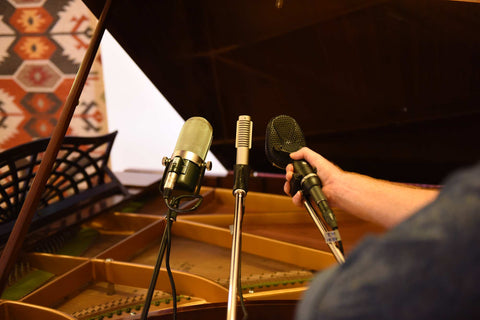Your Cart is Empty
Order Online or Choose Click & Collect from our Artarmon showroom - FREE Shipping on most orders over $100
Menu
-
- Shop Music Gear
- Top Selling Brands
- Hot Deals
- Services
- Christmas Gift Ideas
-
- About Us
- Newsletter Sign up
- Contact Us
- Brand Index
- 1300 13 0202
- Login

Order Online or Choose Click & Collect from our Artarmon showroom - FREE Shipping on most orders over $100
Ribbon Microphone Shootout
October 27, 2015 2 min read 1 Comment

Ribbon microphones are probably the least common microphone choice when it comes to setting up your home or project studio, yet are widely used in professional studios for their delicate, un-hyped natural tone. Large-diaphragm condenser microphones have become widely accepted as the mic you have to have if you could only have one mic. On the whole they sound great, offering a crisp, detailed sound, and are less reliant on a quality pre-amp than a ribbon microphone (especially passive ribbon microphones).
So why choose a ribbon microphone when there are plenty of great, cheap condensers on the market?
Ribbon microphones offer an impressive point of difference to condensers . Some of the most famous recordings and broadcasts have made use of these transparent and beautifully natural sounding microphones. Ribbon mics have a smooth, some may call "dark" tone to them, and lend themselves to toning down harsh instruments like brass and guitar cabinets, but they do much more than this as you'll hear by the recordings below.
We put up a couple of well known and widely respected ribbon microphones - the 4038 from Coles and the R121 from Royer. Plus, just out of curiosity, we also tested the less known and more moderately priced Golden Age R1 mk3 - an active ribbon microphone. Anybody interested in building a recording channel-path that offers something a little different, or is interested in hearing the aural differences each microphone has to offer should read on and listen to the results.
The Recording Session
To conduct this shootout, we were fortunate enough to have access to Studio D, the main recording space at Church Street Studios, Camperdown in Sydney. Multi-instrumentalist and composer Damian de Boos-Smith demoed the mic’s for us on steel-string & nylon-string acoustic guitar, Mandolin, Ukelele, Cello, Drum Kit, and even a Tambourine! Just to hear how they'd handle those high-frequency sizzles. Guy Gross jumped in and played some piano on the stunning vintage Bechstein, (circa 1897) situated in Damian’s live-room.

We tracked through a JLM Audio TMP8; eight-channel pre-amp, into Logic Pro via an Apogee Symphony system clocked at 88.2. The set up was super clean, and hopefully will give you a transparent overview of what each microphone has to offer. At the very least, the test was conducted on an even playing field, as the pre-amps were identical and the microphones situated as equidistant as possible from the source and were all tracked simultaneously.
We have uploaded the results to our Soundcloud page, with links to each instrument in separate playlists. Each instrument was performed across its register and with varying techniques. Be sure to listen with some quality monitors or headphones, and you will surely hear the contrasting tonal character that each microphone can capture. The Coles in particular has a much darker quality for example, with its rich and detailed low frequency response in comparison with the Golden Age or Royer. Check them all out for yourself below, and feel free to share your thoughts with us on Facebook.
Recording Examples
If you're interested in finding out more about ribbon microphones, Royer Labs have some extremely useful information on their website for both using and looking after ribbon microphones, and their history and construction. For further reading please click here.
1 Response
Leave a comment
Comments will be approved before showing up.
Phonse O'Bryan
October 31, 2015
Very informative. I would have liked the new RODE ribbon to be included in this shootout; we’re unlikely to be able to afford a Coles, want something more upmarket than the Golden Age, but very likely to buy a RODE!